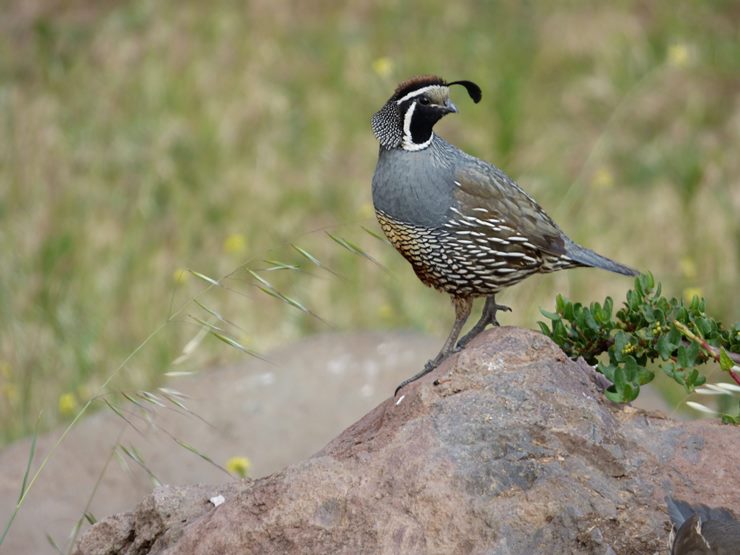Quail are species of ground-dwelling birds in the order Galliformes. Two families of quail contain several genera with many species. These Old World and New World Quail are found all over the world. These are popular game birds and domesticated birds throughout their range.
A group or flock of quail is typically called a Covey.
Additional collective nouns for quail include:
- Bevy
- Battery
- Drift
- Shake
- Flush
- Rout
- Queer
- Bunch
- Plump
- Knob
- Trip
- Run
Two specific quail species have different collective nouns based on their common name. A group of Gambel’s Quail is called a Wagering, while a group of Montezuma quail is called a Revenge.
Table of Contents

The quail diet reflects their ground-dwelling habitat. These birds are omnivorous, eating various plants and insects that they encounter. They prefer eating hard seeds like ragweed, fruits they can reach, and arthropods like beetles, spiders, ants, and grasshoppers.
Quail have specific adaptations that allow them to avoid being easy prey for predators. Despite their short, little legs, quail can run very fast. In addition, quail can lift off from the ground quickly and fly onto low branches.
Farmers around the world raise larger quail species for food, eggs, or farm hunts. This bird is easy to produce. The United States alone raises tens of millions of quail each year. They are more prolific than chickens and other farm-raised birds and eat less because they are smaller.
What is a Pair of Quail Called?
A male quail courts a female by loudly calling to her, posturing with its tail and wings down, and bobbing its head. The female often chooses a larger male for a mate. These birds breed in the spring when temperatures warm up. A pair of quail does not have a specific name.
Quail typically mate for life, although that life is not long. The lifespan of these birds is short, averaging eighteen to twenty-four months, although some wild quail may live longer, depending on the species, predator pressure, and the type of habitat they occupy. Farmed quail live longer.
To create a nest, a female quail scratches a depression into the ground under a dense bush or shrub. They line the nest with softer material, like grasses. The female lays between ten and sixteen eggs in the nest, depending on the species.
In some years, when the weather is good with enough rainfall to produce plenty of seeds, quail may have two broods. In years with harsh winters or drought conditions, quail may only raise one clutch with few chicks.
What is a Group of Baby Quail Called?
Female quail incubate their eggs for about three weeks, depending on the species. Once the baby quail hatch, these chicks or poults can leave the nest the next day. A group of baby quail is called a clutch or brood. Young quail can feed themselves after leaving the nest.
People that see young quail in the wild will notice that they scratch in the soil for food, similar to their parents. The female quail broods the young, guiding them to the places they will forage for food, while the male watches for predators in the area.
Young quail mature around two months after hatching, depending on the species. However, they do not breed until the following breeding season, approximately one year after hatching. The young of some quail species stay with their parents for several months.
Do Quail Flock Together in Groups?
Quail often flock together in groups throughout much of the year. Once the breeding season ends in the fall and throughout the winter, quail roost together in low branches, often within their family groups. Because quail clutches are so large, these flocks can contain many individuals.
These birds often feed together in groups during the morning and late afternoon in open, scrubby areas where they can see the approach of a predator. During the heat of the day and at night, they roost in shaded areas that offer some protection from predation.
Do Quail Migrate?
Some quail populations are migratory. These migratory populations typically exist in more northern regions, in locations at high elevations, and where summer breeding grounds become dry during the winter.
Quail that use these areas for their breeding grounds may migrate to warmer locations, places with lower elevation, and regions that do not experience a dry season during the winter. Some birds make long migrations, while others make only partial migrations.
Other quail populations remain in the same general location year-round. These quail live where the climate does not usually fluctuate between extremes of temperature and precipitation.
Many migratory and non-migratory quail have experienced a decline in numbers. These quail populations have declined for decades. Despite conscientious management practices, these numbers continue to drop. Wildlife managers spend a great deal of time and money trying to understand the reason for the decline and ways to mitigate the low numbers.
